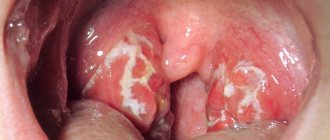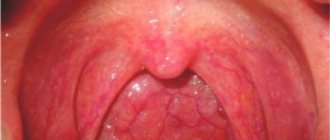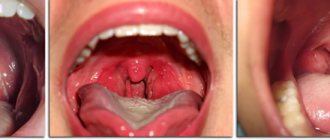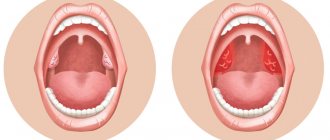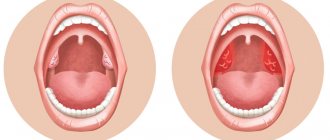The term "tonsillitis" comes from the Latin name for the tonsils or tonsils. These are special paired rounded almond-shaped formations located on both sides between the palate and the root of the tongue, on the border of the oral cavity and pharynx. Their basis is lymphoid tissue; it is responsible for the maturation of lymphocytes (immunocompetent cells) and the development of an immune response with their help.
The palatine tonsils belong to the peripheral immune organs and, together with other tonsils, form the protective lymphopharyngeal ring of Pirogov-Waldeyer. Their task is to recognize and subsequently destroy pathogens and create an immune barrier at the level of the pharynx. Such protection works both against infectious agents penetrating from outside and against one’s own opportunistic flora.
In most cases, this process is asymptomatic. But sometimes it is not possible to quickly destroy the pathogens; they begin to multiply in the natural recesses (crypts and lacunae) of the tonsils and provoke inflammation. This condition is called tonsillitis.
There are 2 forms of the disease:
- Acute tonsillitis or tonsillitis, the duration of the disease usually does not exceed 10–14 days. The nature of the inflammation can be catarrhal, follicular or lacunar. After the pathogen is destroyed, all symptoms of the disease are leveled, and the tonsils are cleared and return to their previous state.
- Chronic tonsillitis, characterized by prolonged inflammation of the tonsils. The tonsils are enlarged, and a purulent-microbial (caseous) substrate is constantly preserved in their recesses.
Chronic form of tonsillitis, why the tonsils become inflamed
Infection is the main cause of inflammation of the tonsils. The acute form of the disease in 70% of cases is caused by viruses, the remaining 30% is caused by bacterial and fungal flora. Therefore, sore throats most often accompany acute respiratory infections and are seasonal.
Damage to the tonsils in chronic tonsillitis in 80% of cases is of a bacterial nature. The main causative agents of the disease:
- β-hemolytic streptococcus.
- Group A streptococcus.
- Staphylococcus aureus.
- Haemophilus influenzae.
- Rarely encountered bacteria: mycoplasma, chlamydia, etc.
Viruses in the chronic form of the disease have a predominantly provocative, destabilizing effect. Acute and chronic recurrent viral infections weaken the immune defense, which creates conditions for the activation of bacterial flora. Hypothermia, acute intoxication, and ingestion of cold or irritating food lead to the same result.
Features of the chronic form of the disease
Chronic inflammation of the tonsils can have several clinical variants:
- Latent form, when the patient does not experience significant discomfort in the throat and does not experience signs of exacerbation of the disease. Such people consider themselves healthy and are not aware of the dormant infectious-inflammatory focus in their throat.
- Periodically relapsing type of disease. Sluggish exacerbations and episodes of clearly defined inflammation of the tonsil itself, adjacent palatine arches and the pharyngeal wall are possible. Between periods of exacerbation, the inflammatory process subsides, but is not completely eliminated.
In chronic tonsillitis, the drainage and natural self-cleaning of crypts (folds) and lacunae (recesses) are disrupted in the tonsils; pus, living and dead bacteria, and toxins are constantly stored in their depths. This maintains constant inflammation, overstimulates sentinel immune cells, and provokes toxic-allergic reactions.
The immune response that forms during chronic tonsillitis is not sufficient to completely suppress the infectious process; it only restrains the activity of pathogens. Disruption of this delicate balance leads to exacerbation of the disease or triggers immune disorders.
Hypertrophy of the palatine tonsils in children
The growth of the palatine tonsils most often occurs in childhood - during the period of active tissue construction and adaptation of the body to its environment. As the body ages, the tonsils gradually decrease in size.
There are cases when the tonsils are enlarged from birth. But most often, their intensive growth serves as a response to increased inflammation of both the tonsils themselves (called tonsillitis or tonsillitis) and neighboring organs. Inflammation develops when:
- frequent infectious diseases;
- allergies;
- irritation of the mucous membrane by chemical or thermal factors.
The tonsils are located on the sides of the pharynx. If they increase slightly, the child does not experience any discomfort (hypertrophy of the tonsils and their inflammation are not the same thing) and does not need treatment. Moreover, with the onset of puberty, their reverse development begins. If they reach a large size and block the lumen of the pharynx, then characteristic signs appear:
- difficulty breathing (especially with a combined enlargement of the nasopharyngeal tonsil - adenoids);
- violation of diction;
- problems swallowing food;
- night cough;
- the child may snore and wake up frequently, and a chronically sleep-deprived baby will behave restlessly during the day.
Why treat chronic tonsillitis?
Chronically inflamed tonsils become a constant source of infection. With a decrease in immunity, it can spread to other tonsils and peripharyngeal tissue, invade the nasal cavity and paranasal sinuses, and descend into the underlying parts of the respiratory tract.
But the inflammatory reaction of the tonsils is not the main problem of chronic tonsillitis. Constant irritation of the immune forces not only weakens the protective response, but also creates the preconditions for the occurrence of abnormal reactions. Antibodies appear in the body, which are initially produced against β-hemolytic streptococcus, but show aggression towards connective tissue.
This secondary pathology is called rheumatism or Sokolsky-Buyo disease. It is a systemic acquired disease with an autoimmune mechanism, with the favorite targets for antibodies being heart valves and the synovium of small joints.
The key focus of streptococcal infection and the site of primary formation of rheumatic autoantibodies is the inflamed tonsils. Therefore, competent treatment of chronic tonsillitis is an effective prevention of rheumatism and its complications.
How to be treated correctly
Competent treatment of chronic tonsillitis includes a set of measures to eliminate infectious inflammation and deep sanitation (cleansing) of the tonsils. This is necessary to prevent relapses of the disease, suppress allergic and autoimmune processes, and restore the protective function of the pharyngeal lymphadenoid ring.
Common mistakes when treating tonsils:
- Only local medicine for sore throat is used, with the rejection of recommended systemic antibacterial therapy.
- The drug is selected by the patient independently, without taking into account the nature of inflammation, composition and sensitivity of the microflora.
- Drugs for the treatment of chronic tonsillitis are taken haphazardly, or instead of recommended medications, a folk remedy for the disease is used.
- Early cessation of treatment, therapy is completed soon after the sore throat subsides and other symptoms of exacerbation decrease.
- Avoidance of treatment between periods of exacerbation, refusal of proposed surgery.
- Late visit to the doctor, at the stage of complications.
This approach is the main reason for the protracted and complicated course of the disease and the formation of drug resistance in pathogens. Treatment of chronic tonsillitis in adults should be carried out comprehensively, under the supervision of a physician.
Features of the acute stage of the disease
Acute tonsillitis or tonsillitis is a rapidly developing and short-lived infectious inflammation of the tonsils, followed by complete regression of symptoms and a return of the lymphoid tissue of the pharynx to its original state. Often the inflammatory process involves the adjacent palatine arches and the mucous membrane of the pharynx, which is called tonsillopharyngitis.
Characteristic manifestations of angina include:
- Rapid onset of the disease, development of the main symptoms within a few hours.
- A sore throat. It intensifies with swallowing, and its localization depends on the side of the lesion.
- Redness, swelling, enlargement of the tonsils and palatine arches. With the catarrhal form of the disease there are no other changes. With follicular angina, whitish-yellow lesions appear on the surface, as if translucent from the inside, and the lacunar form is characterized by the appearance of plaques and purulent films.
- Increased body temperature, signs of general intoxication.
- Enlargement and tenderness of the submandibular and upper cervical lymph nodes.
If the disease is treated incorrectly, the tonsils may remain enlarged and inflamed even after the patient’s well-being returns to normal. In their crypts, purulent plugs remain, and the protective function is disrupted. The tonsils themselves become a focus of infection, which can periodically activate and spread.
Treatment without surgery
Conservative treatment includes general and local drug therapy, physiotherapy, lavage of lacunae and other methods of cleansing the tonsils. Antibacterial, anti-inflammatory, antiallergic, and immunomodulatory agents are prescribed.
Conservative therapy is widely used in modern otorhinolaryngology. But it does not always completely cure tonsillitis. The tonsils may remain enlarged even after drug suppression of the infection and deep cleansing; the risk of relapses and complications remains. In approximately 1/3 of patients, it becomes necessary to treat the disease surgically.
Conservative methods of treatment. Are they effective?
Treatment of acute tonsillitis in children of different ages and adults is traditionally carried out conservatively. But such therapy has a number of disadvantages:
- Antiseptic local remedies for sore throat act superficially and do not last long, and are quickly washed off with saliva. Therefore, when using them, it is impossible to achieve complete cleansing of the tonsil crypts and cope with deep-seated foci of inflammation.
- Local treatment of acute tonsillitis in children is often associated with certain difficulties. Parents are faced with the insufficient effectiveness of rinses and the child’s negative attitude towards the use of sprays and inhalations.
- The use of antibiotics is associated with inhibition of the native microflora of the oral cavity, intestines, and genitals. The resulting dysbiosis (dysbiosis) negatively affects well-being and digestion, and disrupts the functioning of the immune system. Therefore, many parents prefer to treat their child’s disease without using antibiotics, increasing the risk of complications.
- Antimicrobial agents should be selected taking into account the sensitivity of the microflora isolated from the tonsils, and the bacteriological analysis necessary for this takes several days and is not always available.
- Patients often complete treatment immediately after the sore throat disappears, without following the recommended duration of antibiotic therapy. This is fraught with the preservation of a dormant infectious focus, creating conditions for relapse of the disease and the development of microflora resistance.
- In most cases, it is not possible to limit yourself to using only one drug, and complex therapy requires time and adherence to a specific treatment regimen.
To fully cure acute tonsillitis means not only to relieve the patient of intoxication and sore throat. A competent doctor tries to achieve complete sanitation (cleansing) of the tonsils and elimination of the inflammatory reaction, but conservative therapy cannot always provide an adequate solution to this problem.
Operations for tonsillitis: from traditional methods to modern techniques
Indications for surgical treatment:
- The presence of episodes of exacerbation of the disease 2 or more times a year, with a predominance of purulent inflammation.
- Frequent (more than 4 times a year) exacerbations of tonsillitis, even if they occur without complications.
- Exacerbations are rare, but there are signs of complications from the heart, joints, kidneys or other organs.
- The disease is latent (hidden), but has become the cause of the development of rheumatism and other systemic diseases.
For a long time it was believed that chronically inflamed tonsils should be completely removed. This operation is called tonsillectomy. It allows you to eliminate the source of infection, but makes an uncorrectable hole in the protective lymphoid ring of the pharynx.
Currently, tonsillectomy is rarely performed, mainly in cases of severe purulent-destructive changes in the tonsils. In all other cases, ENT doctors give preference to organ-preserving operations, trying to leave an island of functionally active tonsil tissue.
But resection (partial cutting off of the tonsils) carries the risk of relapse of the disease. After all, such a procedure does not guarantee the elimination of all inflamed and infected tissue. The use of a laser improves the result due to an additional disinfecting and immunomodulating effect in the surgical area, but still does not completely solve the problem of relapses. Nevertheless, laser technologies are recognized as a priority in the treatment of tonsillitis.

